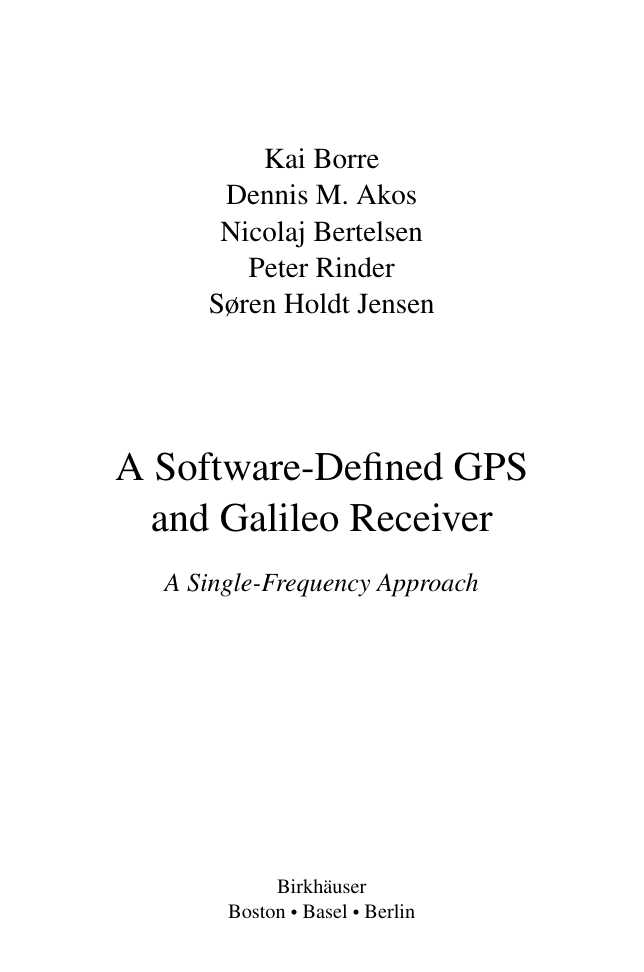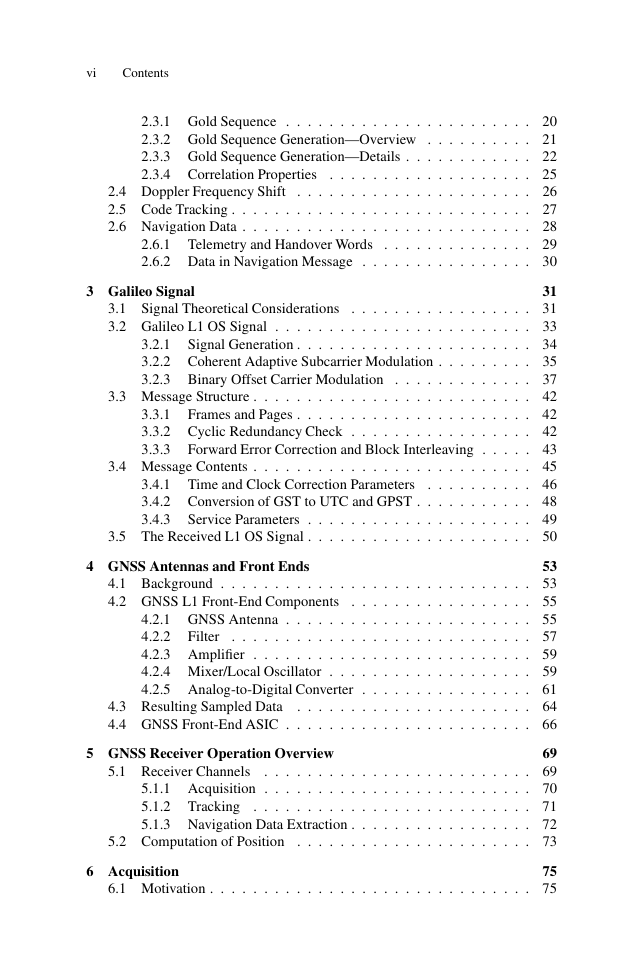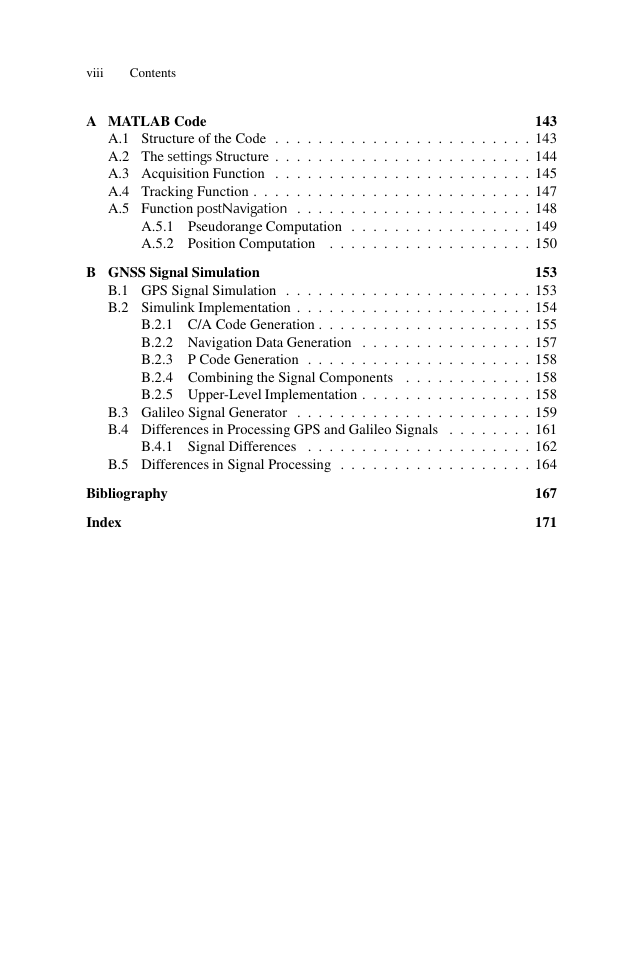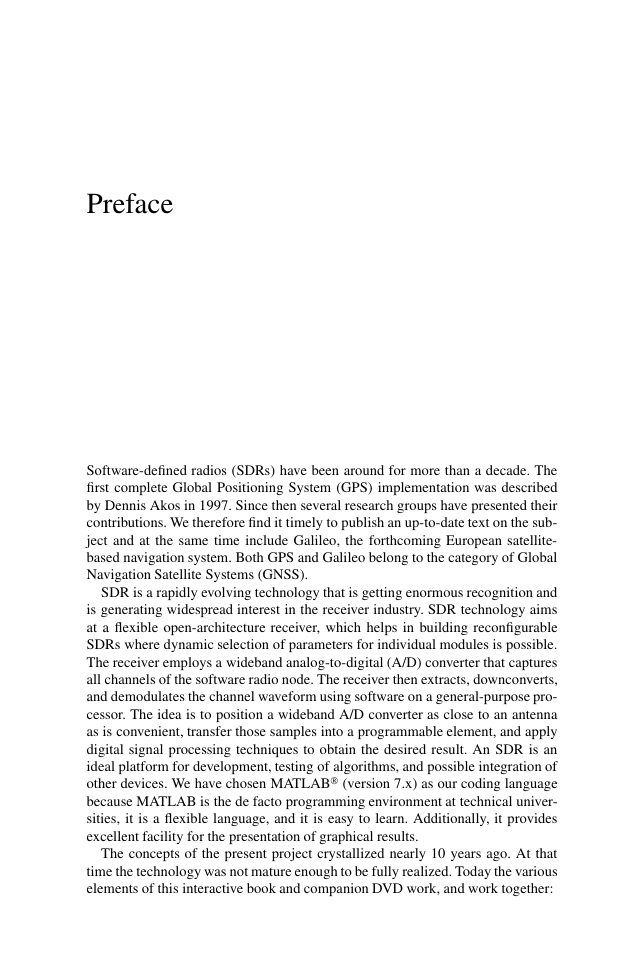�
Kai Borre
Dennis M. Akos
Nicolaj Bertelsen
Peter Rinder
Søren Holdt Jensen
A Software-Defined GPS
and Galileo Receiver
A Single-Frequency Approach
Birkh¨auser
Boston • Basel • Berlin
Contents
Preface
List of Figures
List of Tables
Abbreviations
1 Signals and Systems
. . .
. . . .
1.1 Characterization of Signals . . . .
. . . .
1.1.1 Continuous-Time Deterministic Signals . . . .
1.1.2 Discrete-Time Deterministic Signals . .
. . . .
. . .
. . . .
. . . .
1.1.3 Unit Impulse . . .
. . . .
. . . .
. . .
1.1.4 Rectangular Pulse .
. . . .
. . . .
1.1.5 Random Signals
. . .
.
1.1.6 Random Sequence of Pulses . .
. . . .
. . . .
. . . .
. . . .
. . .
. . . .
. . . .
. . .
. . . .
. . . .
. . .
. .
. . . .
. . . .
. . . .
1.2 Sampling .
. . . .
1.3 Characterization of Systems
. . .
1.4 Linear Time-Invariant Systems . .
1.5 Representation of Bandpass Signals
. . . .
. . . .
. . . .
. . . .
ix
xiii
xvii
xix
1
1
. .
2
. .
3
. .
3
. .
4
. .
6
. .
7
. .
8
. .
. .
9
. . 12
. . 14
17
. . 17
. . 18
. . 20
. . . .
. . . .
. . . .
. . . .
. . . .
. . . .
. . . .
. . . .
. . . .
. . . .
. . . .
2 GPS Signal
2.1 Signals and Data
. . . .
2.2 GPS Signal Scheme . . . .
2.3 C/A Code .
. . . .
. . . .
.
. . . .
. . . .
. . . .
. . .
. . .
. . .
. . . .
. . . .
. . . .
. . . .
. . . .
. . . .
. . . .
. . . .
. . . .
�
vi
Contents
. . .
. . . .
. . . .
2.3.1 Gold Sequence .
. . . .
2.3.2 Gold Sequence Generation—Overview . . .
2.3.3 Gold Sequence Generation—Details .
. . . .
. . . .
. . . .
2.3.4 Correlation Properties
. . . .
. . . .
. . . .
. . . .
. . . .
. . . .
. . . .
2.6.1 Telemetry and Handover Words . . .
2.6.2 Data in Navigation Message .
. . . .
. . . .
2.4 Doppler Frequency Shift
. . . .
2.5 Code Tracking . .
2.6 Navigation Data .
. . . .
.
. . . .
. . . .
. . . .
. . .
. . .
. . .
. . .
. . . .
. . . .
. . . .
. . . .
. . . .
. . . .
. . . .
. . . .
. . . .
3 Galileo Signal
. .
. . .
. . .
. . . .
. . . .
. . . .
3.3 Message Structure . . . .
3.1 Signal Theoretical Considerations
3.2 Galileo L1 OS Signal . .
. . . .
Signal Generation . . . .
. . . .
Frames and Pages . . . .
. . . .
. . . .
3.2.1
. . . .
3.2.2 Coherent Adaptive Subcarrier Modulation . .
3.2.3 Binary Offset Carrier Modulation . .
. . . .
. . . .
. . . .
. . . .
. . . .
. . . .
. . . .
. . . .
. . . .
. . . .
. . . .
. . . .
. . . .
. . . .
. . . .
Forward Error Correction and Block Interleaving . .
. . . .
. . . .
. . . .
. . . .
. . . .
. . . .
. . . .
3.4.1 Time and Clock Correction Parameters
. . .
3.4.2 Conversion of GST to UTC and GPST . . . .
3.4.3
. . . .
. . . .
. . .
3.3.1
. . .
3.3.2 Cyclic Redundancy Check . .
3.3.3
Service Parameters . . .
3.5 The Received L1 OS Signal . . .
3.4 Message Contents . . . .
. . . .
. . . .
. . .
. . .
. . . .
. . .
4 GNSS Antennas and Front Ends
Filter
. . . .
. . .
. . . .
4.1 Background . . .
. .
4.2 GNSS L1 Front-End Components
. . .
. . . .
4.2.1 GNSS Antenna .
. . .
. . . .
4.2.2
. . . .
. . .
. . . .
4.2.3 Amplifier . . . .
4.2.4 Mixer/Local Oscillator .
. . .
4.2.5 Analog-to-Digital Converter .
. . .
. . .
4.3 Resulting Sampled Data
4.4 GNSS Front-End ASIC .
. . . .
. . . .
. .
5.1 Receiver Channels
5 GNSS Receiver Operation Overview
. . . .
. . . .
. . . .
. . .
. . .
. . .
5.1.1 Acquisition . . .
. . .
5.1.2 Tracking . . . .
5.1.3 Navigation Data Extraction . .
. . .
5.2 Computation of Position . . . .
. . . .
. . . .
. . . .
. . . .
. . . .
. . . .
. . . .
. . . .
. . . .
. . . .
. . . .
. . . .
. . . .
. . . .
. . . .
. . . .
. . . .
. . . .
. . . .
. . . .
. . . .
. . . .
. . . .
. . . .
. . . .
. . . .
. . . .
. . . .
. . . .
. . . .
. . . .
. . . .
. . . .
. . . .
. . . .
. . . .
. . . .
. . . .
. . . .
. . . .
. . . .
. . . .
6 Acquisition
6.1 Motivation . . . .
. . . .
. . . .
. . .
. . . .
. . . .
. . . .
. . . 20
. . . 21
. . . 22
. . . 25
. . . 26
. . . 27
. . . 28
. . . 29
. . . 30
31
. . . 31
. . . 33
. . . 34
. . . 35
. . . 37
. . . 42
. . . 42
. . . 42
. . . 43
. . . 45
. . . 46
. . . 48
. . . 49
. . . 50
53
. . . 53
. . . 55
. . . 55
. . . 57
. . . 59
. . . 59
. . . 61
. . . 64
. . . 66
69
. . . 69
. . . 70
. . . 71
. . . 72
. . . 73
75
. . . 75
�
Contents
vii
. . . .
6.2 Serial Search Acquisition .
6.2.1
6.2.2 Carrier Generation . . . .
Integration and Squaring .
6.2.3
. . .
PRN Sequence Generation . . .
. . .
. . .
. . . .
. . . .
. . . .
. . . .
6.3 Parallel Frequency Space Search Acquisition .
6.4 Parallel Code Phase Search Acquisition . . . .
. . . .
6.5 Data Size .
. . . .
. . . .
. . . .
6.6 Execution Time . .
. . . .
6.7 Parameter Estimation . . .
. . . .
. . . .
. . . .
. . . .
. . .
. . .
. . .
. . . .
. . . .
. . . .
. . . .
. . . .
. . . .
. . . .
. . . .
. . . .
. . . .
. . . .
. . . .
. . . .
. . . .
. . . .
. . . .
. . . .
. . . .
7 Carrier and Code Tracking
. . . .
. . . .
7.1 Motivation .
. . . .
. . . .
7.2 Demodulation . . .
. . . .
. . . .
7.3 Second-Order PLL . . . .
. . . .
7.3.1 Damping Ratio . .
. . . .
7.3.2 Noise Bandwidth .
. . . .
. . . .
7.4 Carrier Tracking . .
. . . .
. . . .
7.5 Code Tracking . . .
. . . .
. . . .
7.6 Multipath .
. . . .
7.7 Complete Tracking Block .
. . . .
7.8 Pseudorange Computations . . . .
. . .
. . .
. . .
. . .
. . .
. . .
. . .
. . .
. . .
. . .
. . . .
. . . .
. . . .
. . . .
. . . .
. . . .
. . . .
. . . .
. . . .
. . . .
. . . .
. . . .
. . . .
. . . .
. . . .
. . . .
. . . .
. . . .
. . . .
. . . .
. . . .
. . . .
. . . .
. . . .
. . . .
. . . .
. . . .
. . . .
. . . .
. . . .
8 Data Processing for Positioning
8.1.1
. . .
. . . .
. . . .
. . . .
. . . .
. . . .
. . . .
. . . .
. . . .
8.1 Navigation Data Recovery . . . .
8.3 Computation of Satellite Position .
8.4 Pseudorange Estimation . .
. . . .
. . . .
Finding the Bit Transition Time and the Bit Values . .
. . . .
. . . .
. . .
8.2 Navigation Data Decoding . . . .
. . . .
. . . .
8.2.1 Location of Preamble . . .
. . .
. . . .
. . . .
8.2.2 Extracting the Navigation Data .
. . . .
. . . .
. . .
. . . .
. . . .
. . .
. . . .
8.4.1 The Initial Set of Pseudoranges
. . . .
. . . .
8.4.2 Estimation of Subsequent Pseudoranges . . . .
. . . .
. . . .
. . . .
8.5.1 Time
. . . .
. . . .
8.5.2 Linearization of the Observation Equation . . .
. . . .
8.5.3 Using the Least-Squares Method . . . .
. . . .
. . . .
. . . .
8.5.4 Real-Time Positioning Accuracy . . . .
. . . .
. . . .
. . . .
8.6 Time Systems Relevant for GPS .
. . . .
. . . .
8.7 Coordinate Transformations
. . . .
. . .
. . . .
8.8 Universal Transverse Mercator Mapping . . . .
. . . .
. . . .
. . . .
. . . .
8.9 Dilution of Precision . . .
. . . .
8.10 World Geodetic System 1984 . . .
. . . .
. . . .
. . . .
8.11 Time and Coordinate Reference Frames for GPS and Galileo .
8.5 Computation of Receiver Position . . .
. . .
. . . .
. . . .
. . .
. . .
. . .
. . .
. . .
. . . .
. . . .
Problems
. . 76
. . 77
. . 77
. . 78
. . 78
. . 81
. . 84
. . 85
. . 86
87
. . 87
. . 87
. . 89
. . 92
. . 92
. . 93
. . 96
. . 101
. . 106
. . 107
109
. . 109
. . 109
. . 110
. . 110
. . 111
. . 114
. . 119
. . 119
. . 120
. . 121
. . 121
. . 122
. . 123
. . 125
. . 125
. . 127
. . 129
. . 130
. . 133
. . 134
137
�
viii
Contents
A MATLAB Code
. . . .
A.1 Structure of the Code . .
A.2 The settings Structure . .
. . . .
. . . .
A.3 Acquisition Function . .
A.4 Tracking Function . . . .
. . . .
A.5 Function postNavigation . . . .
. . .
. . .
. . .
. . .
. . .
A.5.1 Pseudorange Computation . .
. . .
A.5.2 Position Computation .
. . . .
. . . .
. . . .
. . . .
. . . .
. . . .
. . . .
. . . .
. . . .
. . . .
. . . .
. . . .
. . . .
. . . .
. . . .
. . . .
. . . .
. . . .
. . . .
. . . .
. . . .
B GNSS Signal Simulation
. . .
. . . .
B.1 GPS Signal Simulation .
. . .
B.2 Simulink Implementation . . . .
B.2.1 C/A Code Generation . .
. . .
B.2.2 Navigation Data Generation .
B.2.3 P Code Generation . . .
. . .
B.2.4 Combining the Signal Components
B.2.5 Upper-Level Implementation .
. . .
. . . .
. . . .
. . . .
. . . .
. . . .
. . . .
. . . .
B.3 Galileo Signal Generator
. . . .
B.4 Differences in Processing GPS and Galileo Signals .
. . . .
. . . .
. . . .
. . . .
. . . .
. . . .
. . . .
.
. . . .
. . . .
. . . .
. . . .
. . . .
B.4.1 Signal Differences
. . .
B.5 Differences in Signal Processing . . .
. . .
. . . .
. . . .
. . . .
. . . .
. . . .
. . . .
. . . .
. . . .
. . . .
. . . .
. . . .
Bibliography
Index
143
. . . 143
. . . 144
. . . 145
. . . 147
. . . 148
. . . 149
. . . 150
153
. . . 153
. . . 154
. . . 155
. . . 157
. . . 158
. . . 158
. . . 158
. . . 159
. . . 161
. . . 162
. . . 164
167
171
�
Preface
Software-defined radios (SDRs) have been around for more than a decade. The
first complete Global Positioning System (GPS) implementation was described
by Dennis Akos in 1997. Since then several research groups have presented their
contributions. We therefore find it timely to publish an up-to-date text on the sub-
ject and at the same time include Galileo, the forthcoming European satellite-
based navigation system. Both GPS and Galileo belong to the category of Global
Navigation Satellite Systems (GNSS).
SDR is a rapidly evolving technology that is getting enormous recognition and
is generating widespread interest in the receiver industry. SDR technology aims
at a flexible open-architecture receiver, which helps in building reconfigurable
SDRs where dynamic selection of parameters for individual modules is possible.
The receiver employs a wideband analog-to-digital (A/D) converter that captures
all channels of the software radio node. The receiver then extracts, downconverts,
and demodulates the channel waveform using software on a general-purpose pro-
cessor. The idea is to position a wideband A/D converter as close to an antenna
as is convenient, transfer those samples into a programmable element, and apply
digital signal processing techniques to obtain the desired result. An SDR is an
ideal platform for development, testing of algorithms, and possible integration of
other devices. We have chosen MATLAB® (version 7.x) as our coding language
because MATLAB is the de facto programming environment at technical univer-
sities, it is a flexible language, and it is easy to learn. Additionally, it provides
excellent facility for the presentation of graphical results.
The concepts of the present project crystallized nearly 10 years ago. At that
time the technology was not mature enough to be fully realized. Today the various
elements of this interactive book and companion DVD work, and work together:
�
x
Preface
– The main text, which describes a GNSS software-defined radio;
– A complete GPS software receiver implemented using MATLAB as well
as sample data sets—available on the companion cross-platform DVD—
allowing readers to change various parameters and immediately see their
effects;
– A supplementary, optional USB GNSS front-end module, which eventually
converts analog signals to digital signals on a Windows or Linux system
(ordering instructions for this hardware can be found on the bundled DVD).
The signals are imported into MATLAB via the USB 2.0 port.
With all three elements, readers may construct their own GNSS receivers and will
be able to compute a position. Is this not exciting?
A GNSS software receiver is by no means a simple device. The one presented in
this book is a single-frequency receiver using the C/A code on L1 for GPS. This
choice has been made for various reasons. First, it keeps the receiver architecture
fairly simple. Second, with the orbital, clock and ionospheric corrections, as well
as the integrity provided by satellite-based augmentation systems (SBAS) such
as the European Geostationary Navigation Overlay System (EGNOS) and Wide
Area Augmentation System (WAAS), L1 accuracies rival that of dual frequency
GNSS receivers. Only future GNSS wideband signals or additional power will
offer performance improvements over the L1 band. Lastly, the forthcoming Euro-
pean Galileo system will offer an L1 component that will provide greater avail-
ability with its additional full constellation of satellites. We include a description
of the binary offset carrier (BOC) modulation, which is to be used in Galileo, to
allow readers to get acquainted with the new signal type.
The book considers the design of the front-end module, explaining how it is
possible to split the enormous amount of information contained in the antenna sig-
nal into parts related to the individually tracked satellites. Details on purchasing
the front-end module designed for this text can be found at: http://ccar.colorado.
edu/gnss.
A complete GPS software receiver was implemented in MATLAB. The receiver
is able to perform acquisition, code and carrier tracking, navigation bit extraction,
navigation data decoding, pseudorange estimation, and position computations. We
were told that nowadays a textbook comes with overheads prepared for the class-
room so that the lecturer’s job is minimized. Actually we have used most of the
present text for various courses during 2004 and 2005, and we are happy to make
this material readily available; it can be downloaded from: gps.aau.dk/softgps.
What follows here is a brief overview of the book’s contents and coverage of top-
ics. Chapter 1 contains a short introduction to deterministic and random signals.
All GNSS codes build on an elementary pulse signal. We investigate its amplitude
spectrum, autocorrelation function, and its Fourier transform, viz. the power spec-
trum. The important sampling process is described. Next, systems and especially
�
















 2023年江西萍乡中考道德与法治真题及答案.doc
2023年江西萍乡中考道德与法治真题及答案.doc 2012年重庆南川中考生物真题及答案.doc
2012年重庆南川中考生物真题及答案.doc 2013年江西师范大学地理学综合及文艺理论基础考研真题.doc
2013年江西师范大学地理学综合及文艺理论基础考研真题.doc 2020年四川甘孜小升初语文真题及答案I卷.doc
2020年四川甘孜小升初语文真题及答案I卷.doc 2020年注册岩土工程师专业基础考试真题及答案.doc
2020年注册岩土工程师专业基础考试真题及答案.doc 2023-2024学年福建省厦门市九年级上学期数学月考试题及答案.doc
2023-2024学年福建省厦门市九年级上学期数学月考试题及答案.doc 2021-2022学年辽宁省沈阳市大东区九年级上学期语文期末试题及答案.doc
2021-2022学年辽宁省沈阳市大东区九年级上学期语文期末试题及答案.doc 2022-2023学年北京东城区初三第一学期物理期末试卷及答案.doc
2022-2023学年北京东城区初三第一学期物理期末试卷及答案.doc 2018上半年江西教师资格初中地理学科知识与教学能力真题及答案.doc
2018上半年江西教师资格初中地理学科知识与教学能力真题及答案.doc 2012年河北国家公务员申论考试真题及答案-省级.doc
2012年河北国家公务员申论考试真题及答案-省级.doc 2020-2021学年江苏省扬州市江都区邵樊片九年级上学期数学第一次质量检测试题及答案.doc
2020-2021学年江苏省扬州市江都区邵樊片九年级上学期数学第一次质量检测试题及答案.doc 2022下半年黑龙江教师资格证中学综合素质真题及答案.doc
2022下半年黑龙江教师资格证中学综合素质真题及答案.doc